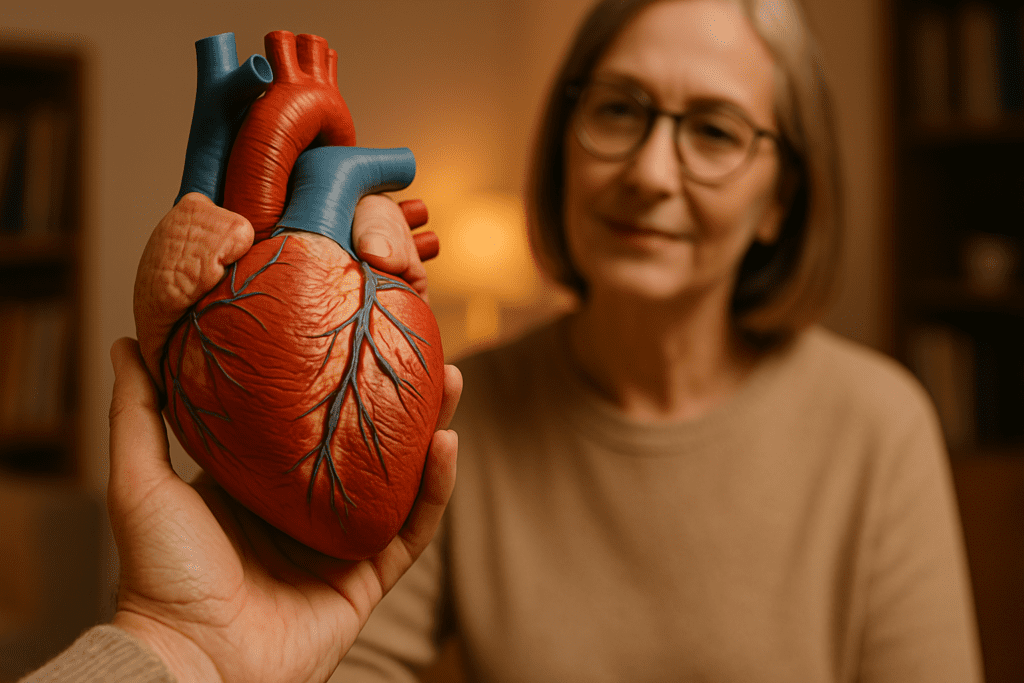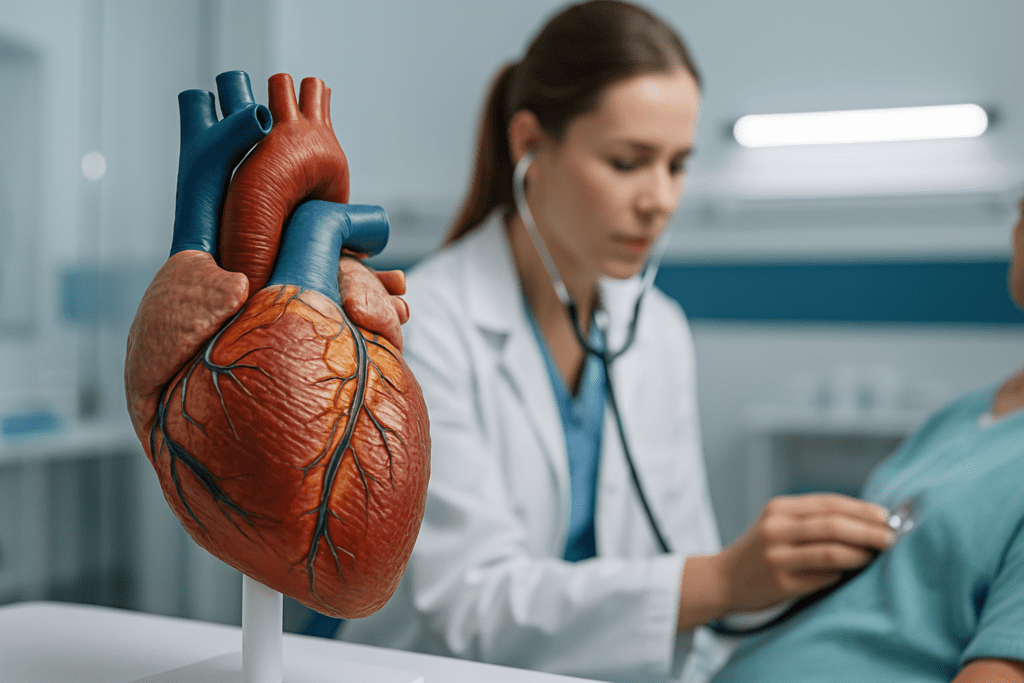The heart is often romanticized as the seat of emotion, the core of human spirit, or the symbolic center of love. But medically and physiologically, it is far more tangible and powerful. So, is the heart a muscle? The answer, rooted in anatomy and cardiovascular science, is a resounding yes. But to simply label the heart as a muscle does not do justice to its remarkable design, structure, and function. The heart is a specialized muscle—one with intricate properties that enable it to function continuously, rhythmically, and efficiently from before birth until our final breath. Its role in cardiovascular health extends beyond mechanical contractions, influencing systemic circulation, nutrient delivery, oxygen transport, and even hormonal regulation.
You may also like: Top Cardiologist-Approved Cardio Workouts to Improve Cardiovascular Fitness and Heart Health Naturally
Understanding heart muscle function goes beyond knowing that it beats. It involves comprehending how the myocardium works in harmony with electrical signals, vascular structures, and biochemical regulators to sustain life. Heart disease remains the leading cause of death worldwide, making this knowledge not only fascinating but vital. When we explore the heart as a muscle, we also unlock critical insights into how to protect it, strengthen it, and recognize when it’s in distress.
Let us dive deeper into the unique nature of the heart as a muscle, its structural and functional characteristics, and its pivotal role in overall cardiovascular health. This journey is not just for cardiologists or medical students—it is for anyone who has a heart and seeks to keep it beating strong.
The Heart as a Muscle: Anatomical and Functional Foundations
To answer the fundamental question—is the heart a muscle—we must first define what muscle tissue is and how the heart fits into that category. The human body contains three primary types of muscle tissue: skeletal, smooth, and cardiac. Skeletal muscles are voluntary and responsible for movement; smooth muscles are involuntary and found in organs like the intestines and blood vessels. Cardiac muscle, however, is unique. It is striated like skeletal muscle but functions involuntarily like smooth muscle. It exists only in the heart and is specifically designed for endurance and rhythmic contraction.
The myocardium—the thick, middle layer of the heart wall—is composed of cardiac muscle fibers. These fibers are branched, interconnected, and contain a high density of mitochondria, allowing them to generate the energy needed for constant contraction. Unlike skeletal muscle, cardiac muscle does not tire easily. This is essential, as the heart must beat approximately 100,000 times per day to pump blood throughout the body. Furthermore, cardiac muscle cells are joined by intercalated discs, which facilitate synchronized contractions through rapid electrical transmission. This architecture allows the heart to act as a coordinated pump, propelling blood efficiently with every beat.
Recognizing that the heart is a muscle provides a critical framework for understanding how it can strengthen, weaken, or become diseased. Just as skeletal muscles can atrophy or hypertrophy in response to use or disuse, the heart can undergo similar adaptations, albeit with different implications for health.
Unique Properties of Cardiac Muscle Tissue
Heart muscle function is defined by several distinctive features that set it apart from other types of muscle tissue. One such feature is automaticity—the ability of cardiac muscle cells to initiate their own electrical impulses without external stimulation. This allows the heart to beat independently of the brain or spinal cord. The sinoatrial (SA) node, located in the right atrium, serves as the natural pacemaker. It generates electrical signals that spread through the myocardium, triggering coordinated contractions.
Another key characteristic is rhythmicity, which refers to the heart’s ability to maintain a consistent and regular pace. This ensures that blood is delivered predictably to all parts of the body. Disruptions in this rhythm—known as arrhythmias—can significantly impair cardiovascular function and require medical intervention.
Contractility, or the ability of muscle cells to shorten and produce force, is also a hallmark of cardiac muscle. In the heart, this translates into the pumping action necessary to move blood. Heart muscle function depends on a finely tuned balance of calcium ions, which initiate contraction at the cellular level. Any disturbance in calcium homeostasis, such as from certain medications or electrolyte imbalances, can compromise contractility and endanger health.
Finally, cardiac muscle demonstrates a degree of plasticity, meaning it can adapt to different physiological demands. During exercise, for example, the heart may increase in size and strength—a process known as physiological hypertrophy. Conversely, in conditions like hypertension or heart failure, pathological hypertrophy can develop, characterized by abnormal thickening of the heart walls and impaired function.

The Relationship Between Heart Muscle Function and Cardiovascular Health
The integrity of heart muscle function is integral to the health of the entire cardiovascular system. When the heart contracts effectively, it maintains optimal cardiac output—the volume of blood pumped by the heart per minute. This ensures that organs and tissues receive the oxygen and nutrients they need while removing waste products such as carbon dioxide.
Poor heart muscle function, on the other hand, can lead to reduced perfusion, systemic congestion, and cellular damage. Conditions such as heart failure arise when the myocardium becomes too weak or stiff to pump blood efficiently. Heart failure with reduced ejection fraction (HFrEF) reflects diminished contractile strength, while heart failure with preserved ejection fraction (HFpEF) reflects impaired relaxation and filling.
A healthy heart muscle also supports blood pressure regulation. The strength and timing of cardiac contractions influence systolic and diastolic pressure. If heart muscle function declines, it can result in hypotension or contribute to the development of hypertension due to compensatory mechanisms. Moreover, a weakened myocardium is more susceptible to ischemia, arrhythmias, and sudden cardiac death.
Cardiovascular health, therefore, hinges on the heart’s ability to perform its muscular duties without interruption. Preserving heart muscle function requires attention to risk factors such as high cholesterol, diabetes, smoking, and sedentary lifestyle—all of which can impair myocardial performance over time.
How Lifestyle Choices Influence Heart Muscle Health
Understanding that the heart is a muscle opens the door to actionable lifestyle strategies that can enhance heart muscle function and protect cardiovascular health. Just as physical activity strengthens skeletal muscle, aerobic exercise improves the strength and efficiency of the heart. Regular cardiovascular exercise—such as walking, swimming, or cycling—increases stroke volume, lowers resting heart rate, and enhances mitochondrial function in cardiac cells. Over time, this reduces the workload on the heart and improves endurance.
Nutrition also plays a vital role. Diets rich in antioxidants, omega-3 fatty acids, potassium, and magnesium support cellular function and reduce inflammation in the myocardium. The Mediterranean diet, for example, has been shown to decrease cardiovascular events by promoting endothelial health and preserving heart muscle function. Avoiding excessive sodium, saturated fats, and added sugars helps prevent hypertension, a major contributor to myocardial damage.
Weight management is another important factor. Obesity increases cardiac workload and is closely linked to left ventricular hypertrophy and heart failure. Losing excess weight can reverse some of these changes and improve myocardial efficiency. Furthermore, avoiding tobacco and limiting alcohol intake are crucial steps in protecting the heart. Smoking, in particular, accelerates atherosclerosis, reduces oxygen delivery, and increases the risk of heart attacks that can irreversibly damage cardiac muscle tissue.
Stress management and quality sleep are often overlooked but equally essential. Chronic stress elevates cortisol and adrenaline, which increase heart rate and blood pressure over time. Meditation, mindfulness, and therapy can mitigate these effects. Likewise, sleep apnea—a condition that disrupts oxygen flow during sleep—has been linked to poor heart muscle function and should be treated appropriately.
Medical Conditions That Affect the Heart as a Muscle
Several medical conditions directly impact the heart’s muscular integrity and performance. One of the most common is myocardial infarction, commonly known as a heart attack. This occurs when blood flow to a portion of the heart is blocked, typically by a clot in a coronary artery, leading to tissue death in that region. The affected muscle becomes scarred and loses its contractile ability, permanently altering heart muscle function.
Another significant condition is cardiomyopathy, a group of diseases that directly affect the myocardium. Dilated cardiomyopathy results in an enlarged and weakened heart that cannot pump blood efficiently. Hypertrophic cardiomyopathy, often genetic, causes abnormal thickening of the heart muscle, which can obstruct blood flow and trigger arrhythmias. Restrictive cardiomyopathy involves stiffened cardiac walls that hinder filling during diastole.
Heart muscle function is also compromised in cases of myocarditis, an inflammatory condition usually triggered by viral infections or autoimmune responses. Myocarditis can range from mild symptoms to severe heart failure and may require intensive treatment, including immunosuppressive therapy.
Valvular heart disease indirectly impacts the myocardium by altering hemodynamics. If a valve fails to open or close properly, it can increase the workload on the heart, prompting the muscle to adapt in maladaptive ways. Over time, this can lead to hypertrophy, dilation, or eventual failure.
Arrhythmias such as atrial fibrillation do not necessarily originate in the myocardium but can affect its performance by disrupting the coordinated contractions necessary for efficient blood flow. Managing these conditions often requires medications that support heart muscle function, such as beta-blockers, ACE inhibitors, or newer agents like SGLT2 inhibitors, which have shown benefits in both diabetic and non-diabetic heart failure patients.
Diagnostic Tools and Tests to Evaluate Heart Muscle Function
Because heart muscle function is central to cardiovascular health, a wide range of diagnostic tools have been developed to assess myocardial performance. One of the most commonly used is the echocardiogram, which uses ultrasound waves to visualize heart structures and movements. It allows clinicians to measure ejection fraction, wall motion, and valvular function—all key indicators of how well the heart is working as a muscle.
Electrocardiography (ECG or EKG) records the electrical activity of the heart and can reveal arrhythmias, signs of past myocardial infarctions, or ongoing ischemia. Although it does not directly visualize muscle function, it provides indirect evidence of myocardial stress or damage.
Cardiac magnetic resonance imaging (MRI) offers more detailed insights into heart muscle tissue, allowing for the detection of inflammation, scarring, or fibrosis. It is especially useful in diagnosing myocarditis and various cardiomyopathies. Similarly, nuclear imaging techniques such as positron emission tomography (PET) or single-photon emission computed tomography (SPECT) can assess perfusion and viability of heart muscle.
Blood tests are also valuable. Biomarkers like troponin indicate acute muscle injury, while natriuretic peptides such as BNP or NT-proBNP help monitor heart failure. These tools, when used in combination, provide a comprehensive view of heart muscle function and help guide treatment strategies.

Supporting Heart Muscle Function Through Medical Interventions
When heart muscle function is compromised, medical interventions can help restore and maintain cardiovascular performance. Medications are often the first line of defense. Beta-blockers reduce heart rate and contractility, allowing the heart to work more efficiently. ACE inhibitors and angiotensin receptor blockers (ARBs) help reduce afterload and prevent remodeling of the myocardium. Mineralocorticoid receptor antagonists and SGLT2 inhibitors have emerged as effective options for reducing hospitalizations and mortality in heart failure.
In some cases, mechanical support devices such as pacemakers or implantable cardioverter defibrillators (ICDs) are necessary to regulate rhythm or prevent sudden cardiac death. More advanced cases may require left ventricular assist devices (LVADs) or even heart transplantation, particularly when medical therapy is no longer sufficient.
Rehabilitation programs that include supervised exercise, dietary counseling, and education on heart health can dramatically improve outcomes. These programs reinforce that the heart, like any other muscle, responds to conditioning and support. Addressing comorbidities such as diabetes, high blood pressure, and sleep apnea further enhances heart muscle function and prolongs quality of life.
The Future of Research in Cardiac Muscle Science
As our understanding of cardiac physiology deepens, new avenues for enhancing heart muscle function continue to emerge. Stem cell therapy and regenerative medicine are at the forefront of experimental treatments, offering the possibility of repairing damaged myocardium. Gene editing technologies like CRISPR hold promise for correcting inherited forms of cardiomyopathy.
Biomaterials and bioengineered tissue scaffolds may one day allow for the replacement of scarred heart tissue, while precision medicine approaches aim to tailor therapies to individual genetic profiles. Researchers are also investigating novel drugs that enhance mitochondrial function, calcium handling, and protein folding within cardiac cells to prevent the progression of heart failure.
Wearable technologies and AI-driven diagnostics are enabling earlier detection and intervention. These innovations underscore the importance of viewing the heart not just as an organ, but as a dynamic, responsive muscle that can be strengthened, protected, and, potentially, regenerated.
Frequently Asked Questions (FAQ): Understanding the Heart as a Muscle and Its Functional Role in Cardiovascular Health
1. Can lifestyle stressors impact heart muscle function even in the absence of physical disease?
Absolutely. While we often associate heart conditions with structural abnormalities or genetic predispositions, chronic stress can significantly influence heart muscle function through indirect but potent mechanisms. Stress activates the hypothalamic-pituitary-adrenal (HPA) axis, leading to elevated levels of cortisol and catecholamines like adrenaline. These hormones increase heart rate, blood pressure, and myocardial oxygen demand, which can strain the heart muscle over time. This is especially concerning in individuals with underlying risk factors, as sustained activation of stress pathways can lead to endothelial dysfunction and subtle impairments in cardiac performance. Understanding that is the heart a muscle in constant physiological communication with the brain and hormonal systems highlights the need for psychological well-being as part of heart care.
2. How does aging affect the heart’s ability to function as a muscle, and can this process be slowed?
Aging introduces multiple structural and functional changes in the heart, many of which center around the degradation of heart muscle function. The myocardium tends to become stiffer with age, reducing diastolic relaxation and leading to conditions such as heart failure with preserved ejection fraction (HFpEF). Additionally, mitochondrial efficiency declines, impairing energy metabolism within cardiac cells. While aging is inevitable, its impact on the myocardium can be mitigated through lifestyle interventions such as resistance and aerobic exercise, which preserve vascular elasticity and enhance myocardial resilience. The more we understand that the heart is a muscle, the better equipped we are to apply anti-aging principles to its care—treating it not as a passive organ but as one capable of adaptation and strength maintenance.
3. How does space travel or microgravity influence heart muscle function in astronauts?
One of the lesser-known yet fascinating areas of research in cardiology involves studying heart muscle function in space. In microgravity environments, the heart no longer has to pump against Earth’s gravitational pull, leading to a reduction in cardiac workload. Over time, this can result in cardiac muscle atrophy—essentially, the weakening of heart muscle due to underuse, much like what happens with skeletal muscles during prolonged bed rest. Returning astronauts often experience orthostatic intolerance due to the diminished muscle strength of the heart, requiring reconditioning on Earth. This research underscores that even in the most advanced settings, the question “is the heart a muscle?” becomes relevant in adapting medical strategies for extreme environments.
4. Are there differences in heart muscle function between men and women?
Yes, sex-based differences in heart muscle function have been widely observed and carry significant clinical implications. Women tend to have smaller ventricular chambers but exhibit greater systolic function and higher ejection fractions than men on average. Hormonal influences, particularly estrogen, offer protective effects that influence vascular tone and myocardial metabolism. Post-menopause, however, the decline in estrogen contributes to an increased risk of heart failure and ischemic events. These physiological nuances suggest that the phrase “is the heart a muscle” must be contextualized by gender, recognizing that the muscular dynamics of the heart are partially shaped by sex-specific biological processes.
5. How does endurance training affect the heart muscle differently from strength training?
Endurance training, such as running or swimming, primarily induces eccentric hypertrophy—where the left ventricular chamber enlarges to accommodate increased blood volume. This type of training enhances stroke volume and improves oxygen delivery capacity. In contrast, strength training tends to result in concentric hypertrophy, thickening the heart walls to manage increased pressure load during lifting. While both types of adaptation reflect positive heart muscle function, excessive or unbalanced training—especially in competitive athletes—can sometimes blur the line between physiological and pathological hypertrophy. These distinctions further validate that understanding is the heart a muscle is crucial not only for general health but also for designing safe, sport-specific training regimens.
6. Can specific medications directly improve heart muscle function without altering heart rate or blood pressure?
Yes, certain newer classes of medications have demonstrated direct benefits to heart muscle function, independent of hemodynamic changes. One such class includes SGLT2 inhibitors, originally developed for diabetes but now known to enhance myocardial energy efficiency and reduce fibrosis. Another example is sacubitril/valsartan, a combination drug that reduces cardiac remodeling and improves ejection fraction in patients with heart failure. These agents exemplify the shift in cardiology toward targeting cellular and molecular aspects of the myocardium itself, rather than solely modifying external metrics like blood pressure. In this context, recognizing that the heart is a muscle enables pharmacological innovation aimed at treating the muscle rather than just the symptoms.
7. Can nutritional deficiencies specifically weaken heart muscle function?
Yes, deficiencies in certain micronutrients can impair heart muscle function and, in extreme cases, lead to cardiomyopathy. For example, thiamine (vitamin B1) deficiency, often seen in chronic alcohol use or malnutrition, can cause wet beriberi—a condition that affects myocardial contractility. Selenium and magnesium are other essential nutrients involved in cardiac electrophysiology and energy metabolism. A lack of these minerals may predispose individuals to arrhythmias or impaired contraction. This understanding reinforces the broader idea that if we acknowledge is the heart a muscle, then it must be nourished like any other muscle—requiring adequate fuel, vitamins, and electrolytes for optimal performance.
8. What role does heart muscle function play in sudden cardiac death among athletes?
Sudden cardiac death in athletes is a rare but devastating event often linked to undiagnosed abnormalities in heart muscle function. Conditions such as hypertrophic cardiomyopathy, arrhythmogenic right ventricular cardiomyopathy, or myocarditis may not present symptoms during routine physical exams. However, these diseases compromise the structural integrity or electrical conduction of the myocardium, increasing the risk of fatal arrhythmias during intense physical exertion. Understanding is the heart a muscle, particularly one vulnerable to inherited or inflammatory diseases, can improve screening protocols for athletes and potentially prevent tragic outcomes. Enhanced imaging, genetic testing, and ECG evaluations are now being incorporated into high-performance sports medicine to assess subtle dysfunctions that would otherwise go unnoticed.
9. Can emotional trauma have a lasting impact on heart muscle function?
Yes, emotional trauma can manifest physiologically in a condition known as takotsubo cardiomyopathy, or “broken heart syndrome.” Often triggered by severe grief, fear, or acute stress, this syndrome causes transient dysfunction in the left ventricle that mimics a heart attack, even though there is no coronary artery blockage. The sudden surge in stress hormones like adrenaline appears to stun the heart muscle, temporarily weakening its ability to contract. While many patients recover fully, some develop lingering effects on heart muscle function, especially if underlying vulnerabilities exist. This fascinating interplay between psychological and cardiac health adds a profound layer to the question: is the heart a muscle only in the anatomical sense, or does it reflect emotional realities as well?
10. What emerging technologies may redefine how we evaluate and support heart muscle function?
The frontier of cardiac care is rapidly evolving, and several emerging technologies are poised to transform our understanding and support of heart muscle function. AI-powered echocardiography platforms can now detect subtle contractile abnormalities that might escape human analysis, while wearable biosensors provide continuous, real-time monitoring of heart rate variability and muscle fatigue. Additionally, 3D-printed heart models created from patient imaging data are being used to simulate surgical outcomes and predict procedural risks. Looking further ahead, regenerative medicine—particularly stem cell-derived cardiac patches—aims to restore damaged myocardium after infarction. These innovations all stem from the foundational knowledge that is the heart a muscle, but not just any muscle—it’s one that now stands at the intersection of biology, technology, and personalized medicine.

Conclusion: Why Understanding the Heart as a Muscle Matters for Your Health
So, is the heart a muscle? Absolutely. But more importantly, it is a muscle unlike any other—resilient, rhythmic, and vital to life itself. Understanding heart muscle function is essential not only for appreciating how this incredible organ works, but for recognizing the steps we can take to preserve it. From exercise and nutrition to early detection and advanced therapies, every decision we make has the potential to support or hinder our heart’s muscular integrity.
In the realm of cardiovascular disorders, the heart’s muscle function is both a cornerstone of diagnosis and a target of treatment. Whether you’re managing blood pressure, recovering from a cardiac event, or simply seeking to stay healthy, knowledge of how the heart operates on a muscular level empowers you to take control of your cardiovascular wellness.
By embracing the idea that the heart is a muscle—one that can be trained, protected, and healed—we gain not only insight but agency. And in doing so, we contribute to a longer, stronger, and more vibrant life, one heartbeat at a time.
cardiac muscle anatomy, myocardial contraction, heart structure and function, cardiovascular physiology, myocardial health, cardiac output explained, electrical conduction in the heart, cardiac muscle adaptation, signs of heart weakness, myocardial regeneration, cardiac rehabilitation, heart failure mechanisms, aerobic exercise and heart health, myocardial remodeling, cardiac energy metabolism, cardiovascular fitness, heart disease prevention tips, how the heart works, cardiac wellness strategies, improving cardiovascular performance
Further Reading:
Is the Heart a Muscle or an Organ?
Heart Anatomy, Function, and Blood Circulation
Disclaimer
The information contained in this article is provided for general informational purposes only and is not intended to serve as medical, legal, or professional advice. While MedNewsPedia strives to present accurate, up-to-date, and reliable content, no warranty or guarantee, expressed or implied, is made regarding the completeness, accuracy, or adequacy of the information provided. Readers are strongly advised to seek the guidance of a qualified healthcare provider or other relevant professionals before acting on any information contained in this article. MedNewsPedia, its authors, editors, and contributors expressly disclaim any liability for any damages, losses, or consequences arising directly or indirectly from the use, interpretation, or reliance on any information presented herein. The views and opinions expressed in this article are those of the author(s) and do not necessarily reflect the official policies or positions of MedNewsPedia.


